 |
 |
 |
| |
Improving HIV outcomes among HIV-infected patients diagnosed with cancer and followed in an integrated, multidisciplinary, infectious disease/cancer clinic: Better CD4 and Viral Load Outcomes After Meshing HIV and Cancer Care
|
| |
| |
IDWeek 2018, October 3-7, 2018, San Francisco
from Jules: this study provides an example/model of a joint comorbidity & HIV care clinic. Although its combining cancer care and an HIV clinic it is su=imilar to combining care in a joint model for treating comorbidities & aging along with HIV care. Certainly just looking at cancer+HIV clinics combination as in this study depicts the potential benefit of combining cancer with HIV care in 1 clinic. Many HIV+ cancer patients complain that they get referred from their HIV doctor to a cancer provider but there is no support, they are on their own after referral to the cancer clinic. Older aging HIV+ need a comprehensive care package that provides full support services and healthcare including for specialists for comorbidities PLUS care coordination by support staff to guide HIV+ through the maze of navigating the healthcare system successfully. Now one might say why should HIV+ get any more or better care than HIV-neg who might not have this level of care I propose. Well for me the answer is easy, HIV+ in general are a much more vulnerable patient population dealing with more multiple diseases than HIV-neg, including more likely to have frailty, cognitive & physical impairment, greater stigma, less mobility; and we invest already in an HIV care system called Ryan White, these services should be carved out of RW on a local level, Shouldn't care for older aging HIV+ be a service RW provides? Its time to recognize the up until this point not recognized - that we have an aging HIV population: currently 50% are over 50 years old & 75% are over 45, but very soon 50% will be over 60.
Mark Mascolini
Integrating HIV care into a cancer center improved HIV suppression rates and CD4 trajectories in a pre- versus post-integration comparison of 600 HIV/cancer patients at the University of Maryland [1]. More clinic visits in postintegration patients may have contributed to their better outcomes.
University of Maryland researchers who conducted this study noted the increased risk of acquiring cancer--and increased cancer mortality--in people with HIV. They cited some evidence suggesting that integrating HIV and cancer care for prisoners and veterans promoted better HIV suppression and CD4 trends. They mounted this study to see if meshing HIV and cancer care at a university medical center would yield similar benefits.
This retrospective chart review focused on HIV-positive adults diagnosed with cancer between January 2012 and December 2016 and seen at least twice in an integrated cancer/infectious diseases clinic established at the university in November 2011. The investigators compared outcomes in the 51 eligible HIV/cancer patients with 548 historical HIV/cancer controls seen in 2007-2011. They called the 51 participants the post- cohort because they received care after integration of HIV and cancer services. The 548 historical controls made up the pre- cohort. The comparison may suffer from year-of-treatment bias because better HIV therapies were available in 2012-2016 than in 2007-2011.
Compared with the pre- cohort, the post- cohort was significantly younger at cancer diagnosis (median 46 versus 51 years, P < 0.01), included a lower proportion of blacks (73% versus 86%) and a higher proportion of whites (27% versus 13%) (P = 0.02), had lower HCV prevalence (25% versus 44%, P = 0.01), and had more advanced cancer at diagnosis (53% versus 32% stage 4, P < 0.0001). Men made up about three quarters of both groups. Fewer than half of both cohorts were taking antiretroviral therapy when diagnosed with cancer (43% and 42%, P = 0.91).
The pre- cohort had a nonsignificantly higher initial median CD4 count than the post- cohort (274 versus 171, P = 0.20), though that difference could be clinically significant. Through the end of follow-up, median CD4 count fell in the pre- cohort (to 238) while rising in the post- cohort (to 250). Viral load measures showed similar proportions with an initial load below 400 copies (42% in pre- cohort, 40% in post- cohort, P = 0.65), though median viral load was substantially higher in the post- cohort (16,802 versus 1985 copies). By the end of follow-up there was a marked trend toward a worse suppression rate in the pre- group than the post- group (63% versus 75%, P = 0.09). Statistical analysis determined that the post- cohort had a 1.41 times higher chance of viral suppression at the end of follow-up, though that association stopped short of statistical significance (95% confidence interval 0.91 to 3.53).
More consistent engagement in care appeared to contribute to the better CD4 and viral load trends in the post- cohort. Average days between clinic visits after cancer diagnosis measured 81 in the pre- cohort versus 51 in the post- cohort (P = 0.0004). Compared with the pre- cohort, the post- cohort had significantly more visits in the first year after diagnosis (5.6 versus 3.7, P < 0.0001) and through 2 years after diagnosis (7.6 versus 4.9, P < 0.001).
The researchers stressed that HIV/cancer patients in the post- cohort (after integration of HIV and cancer services) had a higher initial viral load than the pre- cohort but had a 1.41 times greater chance of viral suppression at the end of follow-up. The University of Maryland team proposed that "integrating HIV care into cancer centers may improve treatment outcomes as it pertains to virologic suppression and CD4 counts."
Reference
1. Cheung H, Stafford KA, Riedel DJ. Improving HIV outcomes among HIV-infected patients diagnosed with cancer and followed in an integrated, multidisciplinary, infectious disease/cancer clinic. IDWeek 2018, October 3-7, 2018, San Francisco. Abstract 2243. Poster at https://idsa.confex.com/idsa/2018/webprogram/Paper71368.html
Improving HIV Outcomes among HIV-infected Patients Diagnosed with Cancer and Followed in an
Integrated, Multidisciplinary, Infectious Disease/ Cancer Clinic
Helen Cheung, BS1, Kristen A. Stafford, PhD, MPH2, 3, David J. Riedel, MD, MPH2
1University of Maryland School of Medicine
2Institute of Human Virology, University of Maryland School of Medicine
3Department of Epidemiology and Public Health, University of Maryland School of Medicine
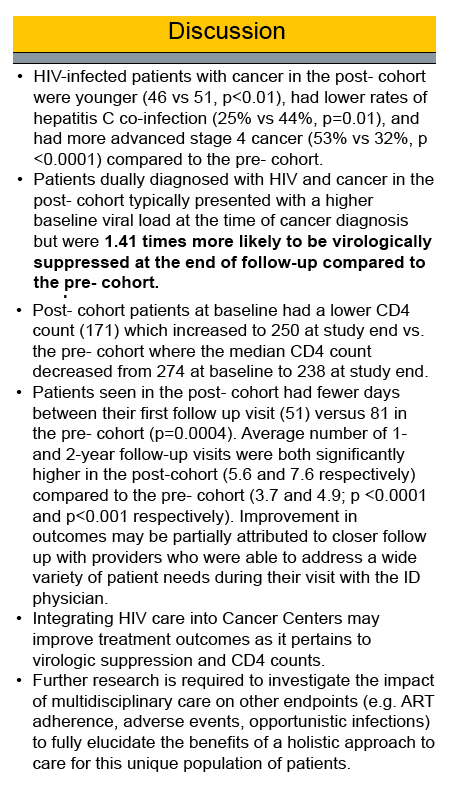
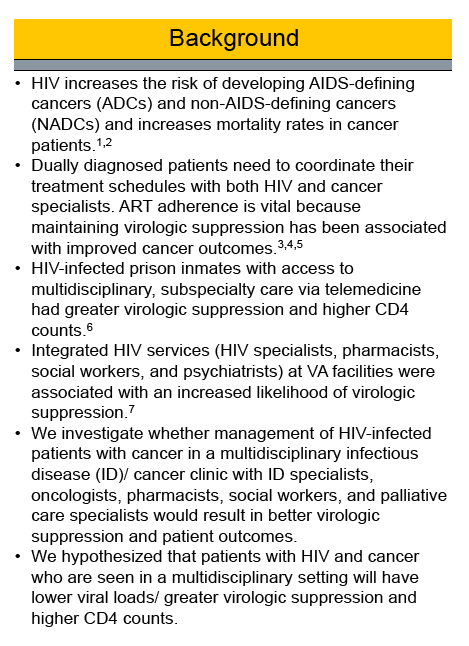
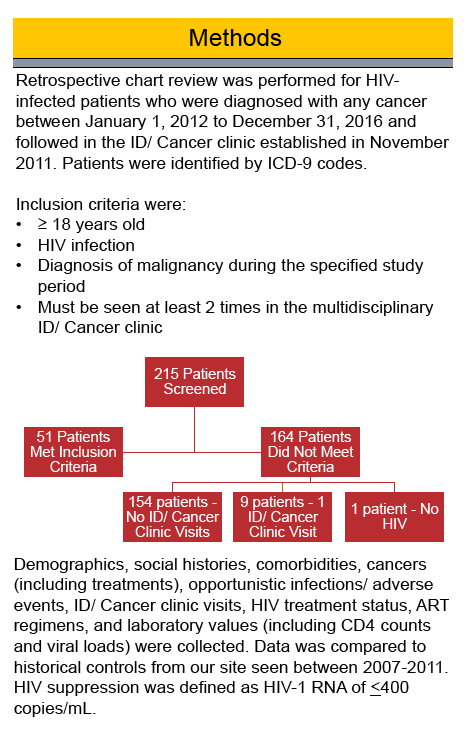

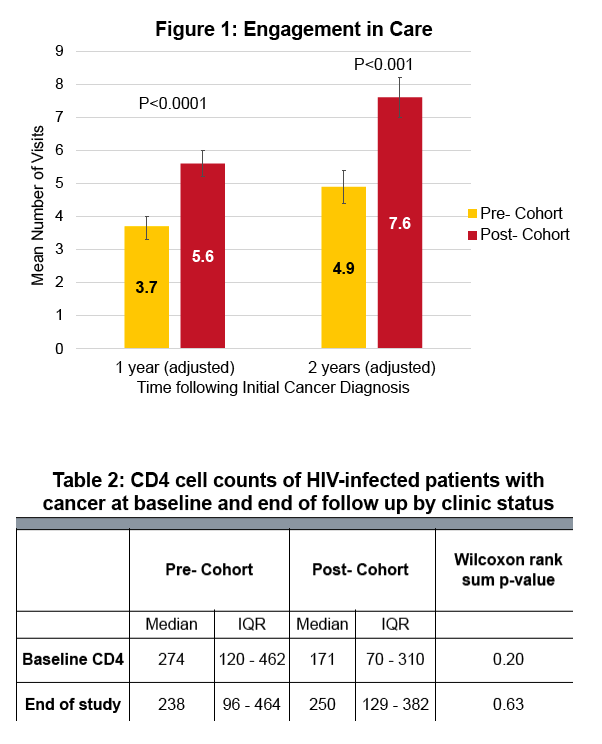
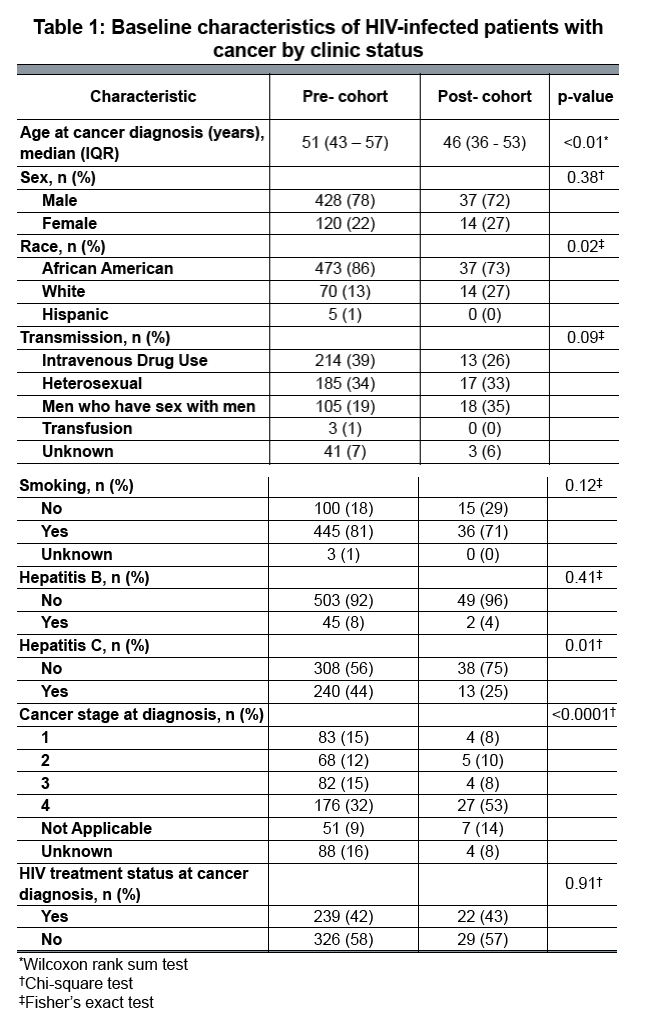
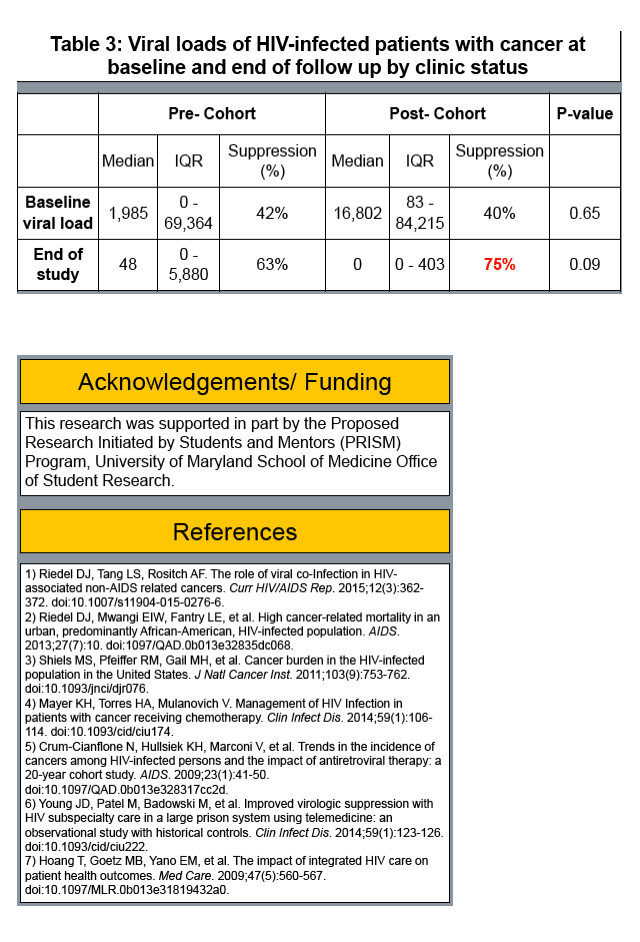
|
| |
|
 |
 |
|
|